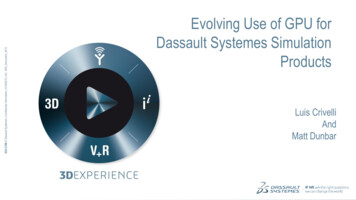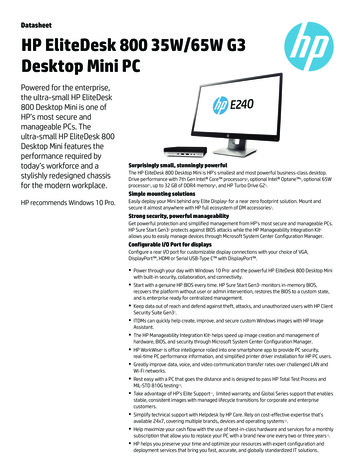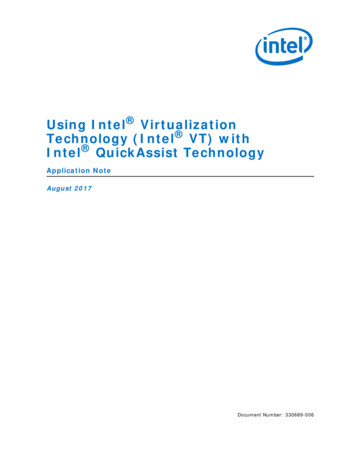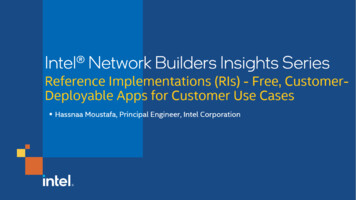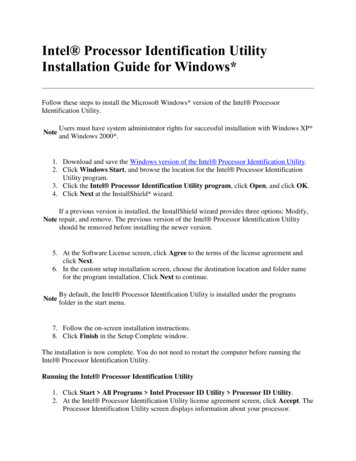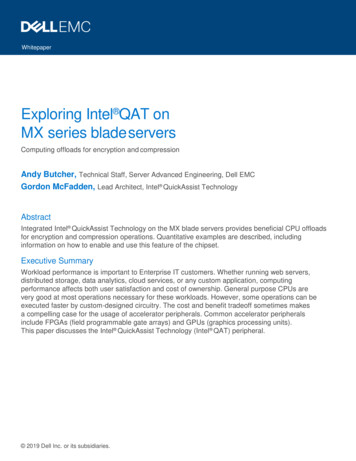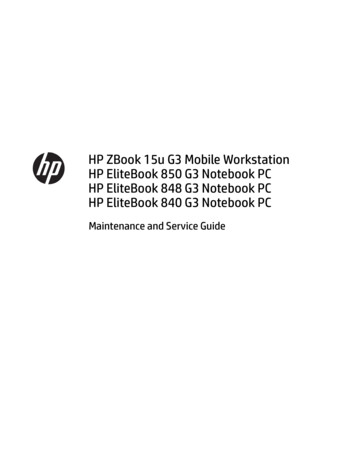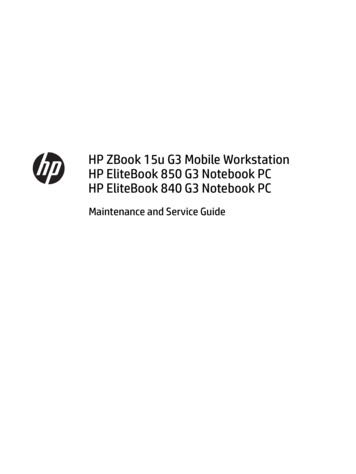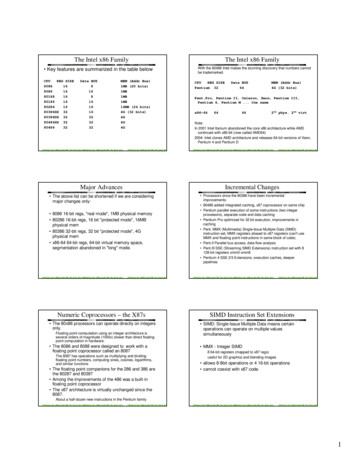
Transcription
The Intel x86 Family Key features are summarized in the table belowCPUREG SIZE80881680861680188168018616802861680386SX 3280386DX 3280486SX 328048632Data BUS8168161616323232MEM (Addr Bus)1MB (20 bits)1MB1MB1MB16MB (24 bits)4G (32 bits)4G4G4GThe Intel x86 FamilyWith the 80486 Intel makes the stunning discovery that numbers cannotbe trademarked.CPUREG SIZEPentium 32Data BUS64MEM (Addr Bus)4G (32 bits)Pent.Pro, Pentium II, Celeron, Xeon, Pentium III,Pentium 4, Pentium M . the samex86-646464252 phys. 264 virtNote:In 2001 Intel Itanium abandoned the core x86 architecture while AMDcontinued with x86-64 (now called AMD64)2004: Intel clones AMD architecture and releases 64-bit versions of Xeon,Pentium 4 and Pentium DMajor AdvancesIncremental Changes The above list can be shortened if we are consideringmajor changes only: Processors since the 80386 have been incrementalimprovements: 80486 added integrated caching, x87 coprocessor on same chip Pentium parallel execution of some instructions (two integerprocessors), separate code and data caching Pentium Pro optimized for 32 bit execution, improvements incaching Pent. MMX (Multimedia) Single-Issue Multiple Data (SIMD)instruction set, MMX registers aliased to x87 registers (can't useMMX and floating point instructions in same block of code). Pent.II Parallel bus access, data-flow analysis Pent.III SSE (Streaming SIMD Extensions) instruction set with 8128-bit registers xmm0-xmm8 Pentium 4 SSE 2/3 Extensions, execution caches, deeperpipelines 8086 16-bit regs, "real mode", 1MB physical memory 80286 16-bit regs, 16 bit "protected mode", 16MBphysical mem 80386 32-bit regs, 32 bit "protected mode", 4Gphysical mem x86-64 64-bit regs, 64-bit virtual memory space,segmentation abandoned in "long" mode.Numeric Coprocessors – the X87s The 80x86 processors can operate directly on integersonly.Floating point computation using an integer architecture isseveral orders of magnitude (1000x) slower than direct floatingpoint computation in hardware. The 8086 and 8088 were designed to work with afloating point coprocessor called an 8087The 8087 has operations such as multiplying and dividingfloating point numbers, computing sines, cosines, logarithms,and similar functions The floating point companions for the 286 and 386 arethe 80287 and 80387 Among the improvements of the 486 was a built-infloating point coprocessor The x87 architecture is virtually unchanged since the8087.SIMD Instruction Set Extensions SIMD: Single-Issue Multiple Data means certainoperations can operate on multiple valuessimultaneously MMX - Integer SIMD8 64-bit registers (mapped to x87 regs)useful for 2D graphics and blending images allows 8-8bit operations or 4 16-bit operations cannot coexist with x87 code.About a half-dozen new instructions in the Pentium family1
SSE (Streaming SIMD Extensions) added 8 128 bit regs xmm0 - xmm7can do integer arithmetic or 32-bit single precision FPup to 4 32-bit operands per registercan coexist with x87 codeFP operations are restricted to simple arithmeticadded with Celeron/Pentium IIITechnology and Economics Adrian King (former Microsoft VP) called the Intel segmentedarchitecture "the triumph of marketing over engineering." Technical decisions based on the economics of the computermarketplace have left us stuck with many things that would havebeen better consigned to oblivion Backwards compatibility is both a blessing and a curse. It makeslife easy because we can still do the old things and use the oldstuff but it makes life miserable because we are still burdened byall of the bad design decisions that people made earlier. Intel processors and Microsoft operating systems are primeexamples.16-bit Code All x86 family processors can run 16-bit codedeveloped in 1979. 16-bit code runs in "real mode." Full capabilities of more advanced processors canonly be used when running in "protected mode." But real mode gives full and remarkably simple accessto all hardware Later we will see the rationale for these terms.SSE2/SSE3 SSE 2 uses the same 128-bit regs as SSEallows 2 64-bit double-precision FP ops/regmaps MMX ops to xmm0 - xmm7 regsadded with Pentium 4 SSE3 is an instruction set extension to SSE2supports arithmetic with complex numbers, integerconversions, specialized graphic operationsRegister Size The 8086 is said to be a 16-bit CPU because itsregisters can hold 16 bits. The 80286 is also a 16-bitprocessor.The 8086 can add, subtract, divide and multiply 16-bitquantities with a single instructionTo handle larger numbers multiple instructions are required. 80386 and later chips are 32-bit processors. 64-bit processors have been on the market since late2001Intel - ItaniumAMD's x86-64 processor was released early 2003Systems and Application Programming "Systems programming" refers to Operating Systemprogramming; applications to apps running under anOS What are the differences?In applications programming, we rely on the services of anoperating system to perform basic tasks such as reading thekeyboard, putting characters on the screen, opening andclosing files.Direct control of the hardware is rare In systems programming, we may be writing programsthat control hardware, control other programs,manage memory, and implement other functions of anoperating system.2
Processor Support for OS Programs The 8086 made no distinction between OS andapplications. Full control of the machine is open toapplications Starting with the 80286, the processor defined 4 levelsof privilege Only programs running on the highest level (PL 0,often called "ring 0") have access to hardware and I/Odevices. Applications are the least privileged (PL 3)Intel 80386 ProcessorsExecution Unit (application prog)General Purpose he Intel 8086 ProcessorExecution UnitGeneral Purpose RegistersAXBXCXDXAHBHCHDHALBLCLDLSIDISPBPBus Interface UnitSegment Registersand Instruction PointerCSDSESSSIPHigh LowFLAGS1 2 3 4 5 6Prefetch QueueALUArithmeticLogic UnitBus ControlLogicAMD x86-64 (Athlon 64)Bus Interface UnitSegment Registersand Instruction PointerAXBXCXDXCSDSESSSFSGSIPSIDISPBPeipeflagsHigh LowFlagsSystems Programming Registersgdtrldtridtrtr (task register)control registerscr0cr1 (80486 )cr2cr3cr4 (pentium)mxcsr (pentium III)debug registersdr0dr1dr3dr4dr6 (debug status)dr7 (debug control)test registerstr6tr7Model-Specific Registers(variable - Pentium)8086EU and BIU The figure is incomplete since it does not show theinterconnections among the units and many other details It is the programmer's view of the processor For our purposes, it is enough to describe what the differentpieces of the processor are without getting into details of how thepieces are wired together The 8086 is a much simpler processor than its descendants The first distinction that is worth noting is between theExecution Unit, sometimes referred to as the EU, andthe Bus Interface Unit, sometimes referred to as theBIU- All registers are "program visible"- All registers are equally accessible to applications and to theoperating system-There are no "privileged instructions“; most CPUs today provide atleast two levels of privilege-Privileged instructions may only be executed by a privileged process.This is the hardware foundation for safe operating systems Starting with the 80286, Intel processors were built withprivileged instructions that are normally only available to the OSand with registers that can only be accessed with theseinstructions The Execution Unit (EU) carries out the instructionsthat the processor receives and is generally the unitthat is directly controlled by the programmer The Bus Interface Unit (BIU) handles addresscomputations and movement of instructions and databetween the EU and the outside world which includesmemory and peripheral devices The programmer generally lacks direct control overthis unit3
The Machine Cycle1.2.3.4.FetchDecodeExecuteRepeat forever. The EU and BIU were designed to operate in parallel. As the EU was executing one instruction, the BIU wouldfetch the next from memory Predecessor of today's pipelining technology that allowsexecution of two or more instructions simultaneouslyThe Execution Unit The EU is shown with 3 main components1. Registers eax, ebx, ecx, edx, ebp, edi, esi, esp (AX,BX, CX, DX, BP, DI, SI, SP)2. The EFLAGS (FLAGS) register3. The ALU We will not discuss the details of the ALU in thistrack of the course; it will be covered in thearchitecture track We will focus on how the registers and memory areaffected by different instructions – the programmer’sviewGeneral Purpose Registers The registers eax, ebx, ecx, and edx (AX, BX, CX, and DX) are oftenreferred to as DATA REGISTERS. The 32 bit registers have fourseparately addressable parts and the 16-bit registers have 3:32-bit eax, 16-bit AX, 8-it AH and AL32-bit ebx, 16-bit BX, 8-it BH and BL32-bit ecx, 16-bit CX, 8-it CH and CL32-bit edx, 16-bit DX, 8-it DH and DL Ant of these registers can be used for arithmetic and logicaloperations on data- Many have specialized purposes But there is no name for the upper 16-bits of EAX and it cannot beaccessed as a 16-bit register x86-64 64-bit registers follow the same scheme:rAX, EAX, AX, AH, ALWhere rAX is a 64-bit register, etc.Index Registers The registers ebp, esp, edi, esi (BP, SP, DI, SI) can only be used as32-bit (16-bit) registers and are often referred to as POINTER andINDEX REGISTERSThese registers are used to reference addresses in memoryBP and SP by convention are used to address the stackDI and SI are used in string processing or block memory operations Note that 32-bit machines allow use of both 16 and 32 bit registerse.g. ESI and SI but while esi can be used to address memory in a32-bit machine SI cannot. 16-bit processors have significant limitations on the use of indexregisters to address memoryThese limitations disappeared in the 32-bit architecture We will soon discuss the special functions of individual registers onthe 80x86 but they are interchangeable for many of the instructions AMD 64 bit machines also have r8 . r15 (pure 64 bit registers)16 and 32 bit Register Usage The 16 and 32 bit machines have parallel register sets Most instructions can operate using 32 bit registers justas they operate using 16 bit registers The one exception concerns the use of index registers toaddress memory The other significant difference between the 16 and 32instruction sets concerns the amount of memoryaddressable by a conditional jump More laterThe eflags / FLAGS Register The eflags/Flags register contains two groups ofbits:1. Bits that specify the status of the machine (StatusFlags)2. Bits that affect the operation of the processor(Control Flags) The Flags register is always treated as a collectionof bits and is never used as a unit on its ownStatus Flags are used to indicate various conditionsthat might occur when an arithmetic operation orcomparison is performedThe Flags register is like a global variable in aprogram. It is shared by all instructions andprocesses4
Instruction SemanticsThe Data RegistersWhen we examine instruction semantics, we have toask two questions:1. How does the instruction affect its operands?2. How does the instruction affect the flags? Although the names probably came from A,B,C and Dthey also have English names that are reminiscent oftheir e RegisterCXecxCount RegisterDXedxData Register It is important to remember that flags are a “sharedglobal resource.”The AccumulatorSpecial Uses of the Accumulator Eax, AX, and AL are all referred to as “the accumulator”Sometimes AH and Al are called accumulator high and accumulator low Eax, AL, or AX are used primarily for arithmetic and logicaloperations on data. It corresponds to the "accumulator" found inolder architecturesMany instructions are optimized to be shorter or faster with theaccumulator as an operatorThese instructions operate on eax, AX, AL but not AH Sometimes eax and edx (AX and DX) together form one largeregister. When multiplying two 32 bit numbers the product is 64 bits and isstored in edx:eax (edx is the high part, eax is low part)-for 16-bit multiplication the result is stored in DX:AX-for 8-bit multiplication the result is stored in AX aloneColon NotationCX:BXes:ediES:DIeax:edx In some cases, a register pair refers to a 64-bit (32-bit) quantity and inother cases, a register pair refers to a 32-bit (20 bit) quantityDX:AX CX:BXCS:IP ES:DI32 bits20 bitsedx:eaxcs:eipThe 386 and later processors have multiplication instructionsthat are more general but discard the upper bits of the product Other specialized instructions such as sign-extensionand table-lookup use the accumulator Input and Output require the use of the accumulator. Itis the only register that can store receive data from anI/O device or send data to an I/O deviceThe Base Register (ebx / BX) Register "pairs" are frequently written with a colon:eax:edx The accumulator MUST be used in arithmeticoperations such as full-precision multiplication andany divisionecx:ebx 64 bitses:edi32 bits The rule is that if addresses are involved, it is a 32-bit (20-bit) quantity. If two general purpose registers are involved it is a 64-bit (32-bit)quantity. This will make more sense after we discuss effective address formationand segment registers later ebx and BX are known as the base register BH and BL are base high and base low registers BX was called the base register because it is used in 16bit code as an index register to store the base addressfor array accessesThe use of bx as an index register is a 16-bit peculiarity.AX, CX and DX cannot be used as index registers while eax, ecxand and edx can be so used Note that 8 bit registers are NEVER used to storeaddresses and 16-bit registers are not used to storeaddresses in a 32-bit program BX also has some other specialized uses such as thetable-lookup instruction XLAT5
The Count RegisterThe Data Register ecx and CX are known as the count register Many iterative instructions work with a count in CX orecx: edx (DX) is probably called the data register becausethey couldn't think of a better word that starts with D DX is used most often for the same purposes as AX –arithmetic and logical operations – because CX andBX have specialized purposes DX does have some specialized purposes, but fewerthen other registers:Loops: loopd, loop, loope, loopne, etcBlock memory ops: movs, cmps, stos, etcCL is used as counter by some rotation or shift instructionsBlock I/O instructions: ins, outsMultiplication and Division use both eax and edx (AX and DX)and cannot use other registersDX is the only register than can hold an address in I/O spacefor the IN and OUT instructions. Even in 32-bit processors the16-bit DX is used for this purposeSome sign-extension instructions use DX or edxGeneral Purpose? We have seen that all of the so-called “general purpose”registers actually have specialized uses (some are moregeneral-purpose than others!)The Pointer and Index Registers This group of four registers is used almost exclusivelyfor memory access edi, esi, ebp, esp (DI, SI, BP, SP) This is characteristic of CISC (complex instruction set)computers Contrast with the Motorola 68000 series (also CISC, butless so than Intel)8 data registers named D0 – D79 address registers A0 – A7 and A7’Any operation that can be done on a data register can be done inany data registerAny operation that can be done with an address can be done withany address register (except A7 and A7’)The “Index” Registers edi (DI) and esi (SI) DI is “Destination Index” and SI is “Source Index” The names derive from their association with thestring or block memory instructions MOVS, CMPS,SCAS, LODS and STOS where they are impliedoperands In 16-bit code only BX, SI and DI may be used asgeneral purpose index registers (pointers to memory) In 32-bit code eax, ebx, ecx, edx, esi and edi may allbe used Note that esp (sp) and ebp (bp) are also pointerregisters but are associated with the stack.Note that 16-bit code uses the 16-bit index registers while 32bit code uses the 32-bit index registers esp/SP can ONLY be used with the stack ebp/BP is intended for use the stack, but can (withextra instructions) be used for general memory access edi/DI and esi/SI are general purpose index registersbut are also associated with string or block memoryinstructionsThe “Pointer” Registers ebp (BP) and esp (SP) BP stands for Base Pointer and is used for addressingdata on the stack (more on this topic later) It might be better named the ‘Frame Pointer’ becauseits primary usage is to point to structures called stackframes (aka activation records) SP stands for Stack Pointer and always points to thetop of the stackWe will explain the stack and its significance later in muchgreater detailHardware stacks were developed to provide hardware supportfor programming languages6
Bits in the FLAGS RegisterEFlags The following figure illustrates the structure of the flagregister (bits are numbered using hex) The 32-bit equivalent of the FLAGS register is calledthe EFLAGS registerFlagOD I T S Z A P CBit# F E D C B A 9 8 7 6 5 4 3 2 1 0FlagBit#NT IOPL O D I T S ZAPCF E D C B A 9 8 7 6 5 4 3 2 1 0FlagID VIPVIF AC VM RFBit# 1F 1E 1D 1C 1B 1A 19 18 17 16 15 14 13 12 11 10 A useful mnemonic for flags is to mentally pronounce“ODITSZAPC” OSZAPC bits are STATUS FLAGS and are set by theprocessor as instructions are executed DIT bits are CONTROL flags and are set by theprogrammer to control the way that certain instructionsexecute or the way that the processor itself works Changes to the Flags since the 8086 are relevant onlyto Systems programming. Use of the Flags by applications is unchanged since1979.The Status Flags - OSZAPCThe Status Flags - OSZAPC The descriptions below are typical meanings. Individual instructionsmay supply different meaningsThe CARRY FLAG (CF) (bit 0 of F) is set to 1, if there has been acarry or borrow out of the MSB following and arithmetic operation.Otherwise it is set to 0.The OVERFLOW FLAG (OF) (bit B of F) is set to 1 if a signed overflow hasoccurred during an arithmetic instruction. Otherwise it is set to 0. Example of specialpurpose: after multiply, indicates if low-order part of product is valid by itselfCF also is affected by many other instructions; for example following ashift or rotate it has a copy of the last bit affectedThe SIGN FLAG (SF) (bit 7 of F) is set to 1 if the result of the last operation isnegative (leading bit is 1), to 0 otherwise. Typically the sign flag is always a copy ofthe MSB of an instruction destinationThe ZERO FLAG (ZF) (bit 6 of F) is set to 1 if the result of the last operation is 0, to0 otherwise. Since a compare instruction (CMP) is essentially a subtractioninstruction, ZF set indicates equality; clear is inequalityThe AUXILIARY CARRY FLAG (AF) (bit 4 of F) is set to 1 if there has been a carryor a borrow between nibbles. It is used internally for BCD arithmetic and is rarely ofinterest to a programmerCF is also used extensively to pass Boolean parameters CF and ZF are used most frequently in programmingSF is nextOF is primarily of use for signed arithmeticPF is primarily of interest for communications (which includeshardware device drivers) AF is used only internally by BCD adjustment instructionsThe PARITY FLAG (PF) (bit 2 of F) is set to 1 if the result of an operation has evenparity, to 0 if it has odd parity. Obviously this flag is useful for communicationsapplicationsThe Control Flags: DIT Control Flags affect the operation of the processor itself D Direction Flag; T Trap Flag; I Interrupt EnableFlag If the DIRECTION FLAG (DF) (bit A of F) is set to 0 allstring/block memory instructions operate from low tohigh memory Example: REP MOVSD copies 4 bytes of memorywhose location is given by [ds:esi] to memory whoselocation is given by [es:edi] Then both edi and esi are incremented by four. The instructions continues for the number of operationsspecified in ecx If DF is set to 1, then edi and esi are decremented ratherthan incrementedThe Control Flags: DIT If the TRAP FLAG (TF) (bit 8 of F) is set to 1, the CPU“single-steps,” pausing after each instruction. If is set to0, the CPU works as usual. Clearly the processor doesn’t actually pause. What happens is that control is turned over to adebugger whose address is found in Interrupt Vector 3(more on this shortly) TF is used only by debuggers.7
The Interrupt Enable Flag IF enables and disables interruptsIf IF 0 interrupts are disabled and the machine will not respond toany external hardware eventIf IF 1 interrupts are enabled and machine operation proceedsnormally Examples of hardware that generate interrupts are thekeyboard, the clock, disk drivers, printers etc. Interrupts may be disabled so that the operating systemcan execute critical regions of code that cannot beinterrupted without disrupting the operating system When an interrupt occurs IF is set to 0 automatically Normally an interrupt handler will enable interrupts as thefirst instruction; if critical handling is necessary theninterrupts will be enabled as soon as the critical sectionhas executedThe World’s Shortest Useful Program! The following assembler codeclijmp short Can be assembled to a .com file of three bytes (e.g,halt.com)FA EB FE When executed this code will immediately halt anymachine running Windows 98, Windows ME, anyolder version of Windows or MS-DOS The CLI instruction disables interrupts The next instruction jumps to itself (a very tight loopindeed) The machine is dead; it can only be powered offIF and VIF Two of the bits added to the eflags register in the 80486 are:VMVIFMachine is in virtual-8086 modeVirtual Interrupt Flag Because IF is a critical system flag, it should not be accessible toanything other than the operating system The purpose of VIF is to simulate the operation of IF in virtual-8086mode When Microsoft created Windows 95 as a 32-bit protected-modeoperating system they found that protecting IF with VIF resulting isabout a 15% decrease in speed for 16-bit code They felt that this would be unacceptable particularly for games(notable for direct control of hardware) and might cause consumerrejection of the OS By contrast the Windows NT operating system was intended forbusiness and always protected IF The NT lineage includes Windows 2000, Windows XP, and VistaThe Bus Interface Unit This unit is divided into the following majorcomponentsThe Segment Registers: CS, DS, ES and SS(32 bit processors have FS and GS)The Instruction Pointer: eip (IP)Other System FlagsFlagBit#NT IOPL O D I T S ZAPCF E D C B A 9 8 7 6 5 4 3 2 1 0FlagID VIPVIF AC VM RFBit# 1F 1E 1D 1C 1B 1A 19 18 17 16 15 14 13 12 11 10 IOPL (80286) I/O Privilege Level (2 bits, 0-3)A process that attempts an I/O operation will be interrupted if itsprivilege level is insufficient for the attempted operation NT (80286) Nested TaskDetermines if coprocessor state must be saved in task switch AC (80486) Alignment CheckCauses interrupt if memory access is not on a 4-byte boundary RF (80386) Resume FlagDetermines interrupted instruction can be resumed VIP (Pentium) Virtual Interrupt PendingIndicates that a virtual interrupt is awaiting handlingInstruction Pointer Eip (IP) is the Instruction Pointer or Program Counter It points to the next instruction that is to be executed eip/IP cannot be changed directly (i.e., as an operand ofan instruction), but changes ONLY as the result ofexecuting instructions such as Jumps, Calls, andInterruptsThe Prefetch QueueThe Bus Control Logic8
Segment Registers The segment registers (segregs) are 16-bit registers only and areused to fully access the memory of the 8086Without using the segregs in the 8086, a program can only access 64KB of memoryWith segment registers, a program can access the full 1 MB ofmemory that the 8086 can address The segment registers have the following names:CS Code SegmentDS Data SegmentSS Stack SegmentES Extra SegmentFS, GS (No special names) Any address register is normally associated with a specificsegment register when the bus interface unit calculates anaddress This also applies to 32-bit processors and 64-bit processors thatare not operating in “long” mode Note that segment registers are 16 bits even in 32 or 64 bitprocessorsSegRegs in 32-bit Processors The 80386 added FS and GS registers. These have no assignedspecial purposes or even namesSegment registers remain 16 bits even in 32-bit processorsSegment registers in 32-bit processors are often referred to as "Selectors"rather than segment registers In 16-bit processors, segment registers contain part of the addressused for a memory reference In 32-bit processors, segment registers contain pointers into one oftwo possible tables of 64-bit segment descriptors:Local Descriptor Table(LDT)Global Descriptor Table(GDT)The SegRegs CS - Code SegmentThis register is used in conjunction with eip/IP to determine theaddress of the next instruction to be executedNo other registers are associated with CS SS - Stack SegmentThis register is used in conjunction with esp/SP (Stack Pointer) forstack operations. ebp/BP also is associated with SS. DS - Data SegmentBy default, when the general purpose registers eax, ebx, ecx, edx,esi and edi are used as index registers, they refer to this segment(In 16-bit processors this includes only BX, SI and DI)Any direct references to memory (e.g, mov ax, count) is DS relative ES - Extra SegmentCan be used as needed by the programmerBut with string instructions, edi/DI is associated with ES rather thanwith DSSegment Register Operations Only a very few instructions can affect the segmentregisters directly The only operations that can be performed are loadsand stores, and even these are restricted. It is not possible to perform arithmetic, logical or bitmanipulation operations directly on a segment register Thus, in 16-bit mode, the segment registers have "real" addresses More on this when we discuss effective address (EA) computationSegRegs and 16-bit Executables MS-DOS provides two types of executable programs: EXE and COMfilesCOM files ignore the segment registers and the entire program iscontained in 64KB64KB of memory is a lot of memory for an assembly language program The A86 assembler is only about 24KB and is a very sophisticated piece ofcode The original Turbo Pascal was only about 35 KB of code and included acompiler, a text editor and a debugger All 4 segment registers have the same values when a .COMprogram is executed EXE files (even small ones) have separate data, code and stacksegments. Segment registers normally have different values when an EXEprogram is executed.32-Bit Flat Model Programming .COM files are restricted to the 16-bit MS-DOS operating system .COM files contain a pure "load image" - as opposed to .EXEfiles, which have some "blank addresses" that are filled in at loadtime. .COM files have an unsegmented (flat) 64-KB address space Although this might appear to be an obsolete technology, 32-bit.EXEs are normally constructed in a similar manner In the 32-bit flat model, DS, ES and SS are identical and refer tothe same area of memory (ALL of it) referred to by CS: a 4GB flataddress space Segment registers can be ignored and you can program in amanner similar to DOS .COM programming9
20-Bit Effective Address (EA) Computation The standard 8086/8088 chip can address 1 MB of memory.Addresses are 20 bits and range from 00000h to FFFFFh Since address registers are 16-bits, how do you address 20-bitmemory? Answer: combine two 16-bit register so 16 16 20 The Segment registers mentioned above supply the "first four" digitsand the other registers supply the "last four".Segmented Addresses The main idea here is how to express an N-place number usingnumbers with fewer than N digits. For example, how would you express 3 digit decimal numbers usingtwo decimal digits?999 99:9 93:69 90:99 94:59 etc. In general, a single memory address can have many differentequivalent expressions.Consider the address 0800:0100In 5-digit hex this is the address 08100But it can also be expressed as: In plain English, to get the complete address take the number in asegment register, multiply by 10H (shift left 4 bits) and add the valuein a regular register ("the offset"). Addresses are often given in the form Segment:Offset.For example, 2349:1AB8 gives23490 1AB8 00080F:0010. The fact that a single address has many valid representations makesoperations such as comparing pointers for equality problematicReal and Protected ModeReal-Mode Addresses Protected Mode addressing (where the CPU can access morethan 1MB of memory) is radically differentThe Segment Registers are used to point into tables of descriptorsA descriptor describes a segment's location, length and access rightsSegment:Offsetsegmentoffsetx16 "Real mode" derives its name from the fact the segment registersin this mode contain "real" addresses You can do address arithmetic with segment register values (butnot in the registers themselves) In protected mode, the numerical value of the segment registerhas NO relation to the actual address Address arithmetic is not possible with protected mode segmentregistersPhysical Address:EA Computation in 32-Bit Protected Mode Selector (segment register) layout:Segment Descriptor Format6332Base[31.24]Index15Operand’s effective addressRADCRLimitGDSVP P SX / / A[19.16]VLLDWBase[23.16]TI RPL32Base[15.0]1 031 Index (Bits 3-15) 13-bit values allows 8,192 entries ina descriptor table Table Indicator (Bit 2) (1 Local DT, 0 Global DT) Requested Privilege Level (Bits 0-1) must be privilege level stored in segment descriptorLimit[15.0]0 Address computation1. Selector indexes
"Systems programming" refers to Operating System programming; applications to apps running under an OS . It is the programmer's view of the processor For our purposes, it is enough to describe what the different . The registers ebp, esp, edi, esi (BP, SP, DI, SI) can on


